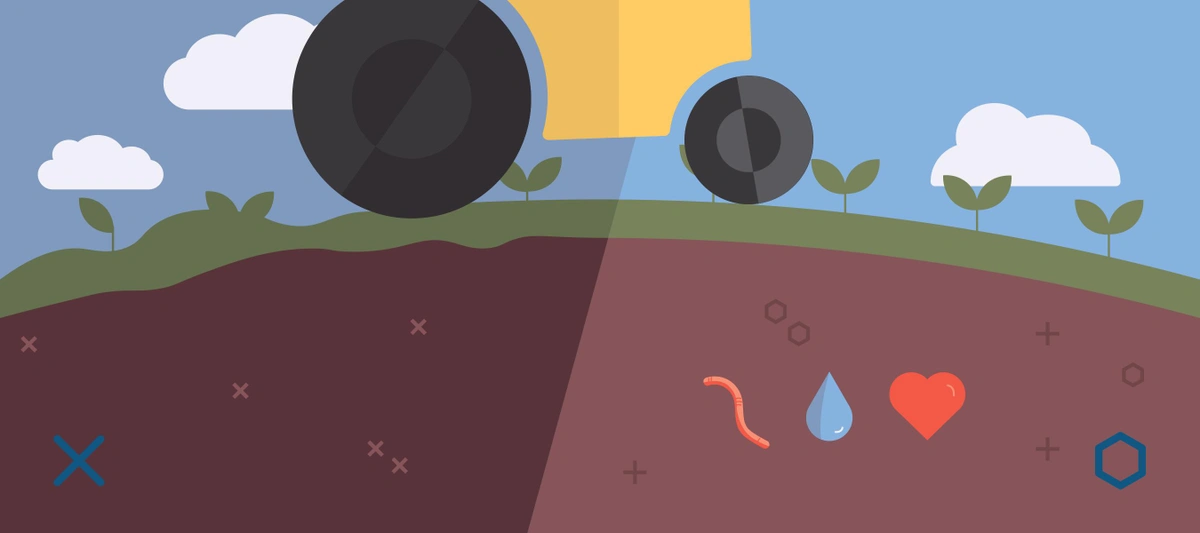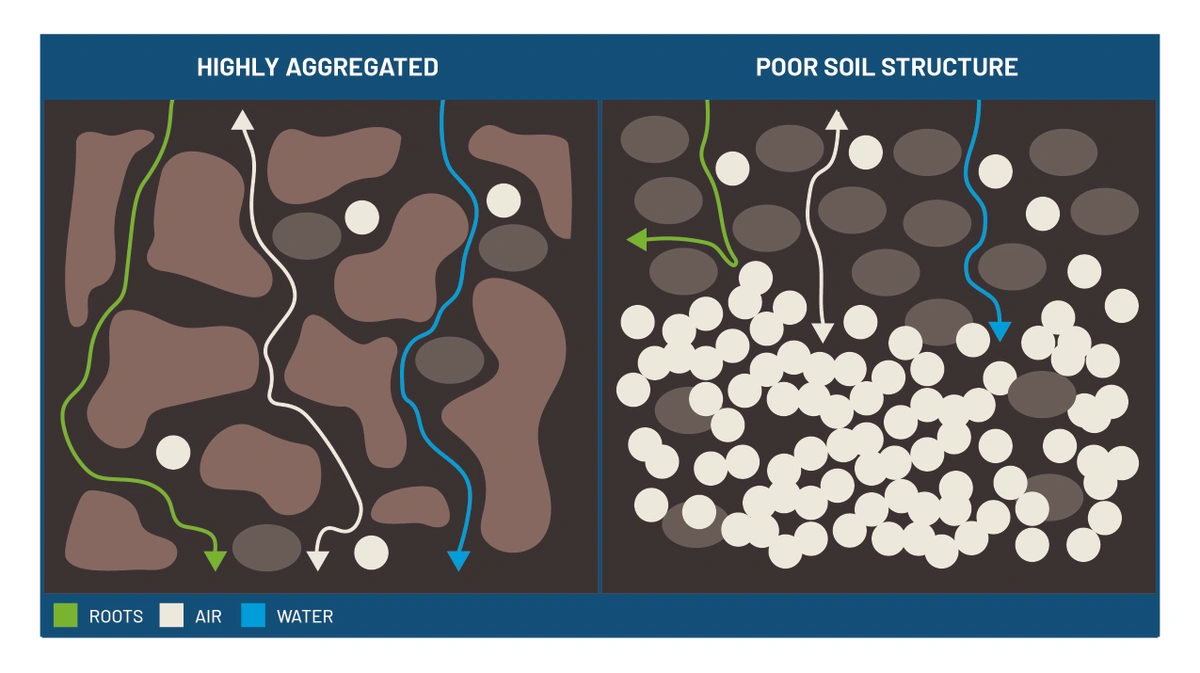Aggregate stability: What it does and how to use it
by Ryan Stockwell
Aggregate stability provides not only an indicator of past practices, but also an important component of healthy, productive soil.

Certainly we’ve all heard of soil carbon and soil organic matter by now and know they are key to healthy, productive soils. But perhaps you haven’t heard much about aggregate stability and its soil function.
Aggregate stability is the ability of a soil aggregate to remain intact… basically the measure of a soil’s physical strength. The higher the soil’s aggregate stability, the more that soil can withstand tractor traffic without compaction or erosion. Also, aggregate stability helps maintain and build water infiltration, deep soil water percolation, and water holding capacity, along with aggregate surface space for nutrient exchange.

Simply put, improving aggregate stability improves all of these functions, which in turn translates into:
- improved drought resistance
- increased ability to drain excess moisture
- faster field accessibility after a rain event
- compaction avoidance
- improved ability to deliver nutrients to plants
- reduced erosion
The strategy to improve soil aggregate stability is straightforward—1) reduce tillage, 2) increase the time the soil has living roots in it, 3) increase the amount of residue on the soil surface, and 4) encourage earthworm populations. In essence, carbon farming practices help you to not only sequester carbon in your soils, but improve aggregate stability as well. Stacking multiple carbon farming practices will also increase the speed at which soil aggregate stability is accumulated.
There are a few ways to measure your soils’ aggregate stability as it changes over time:
- The Slake test: Place a dry chunk of soil in a wire mesh container and then submerge the soil at the surface of a container of water. Measure the amount of soil that slakes off the chunk in a given period, or how long it takes for the soil chunk to fully lose its structure. The longer it takes for the soil clod or chunk to slake or lose its structure the better your soil’s aggregate stability. Of course soil type will have an impact on aggregate stability, but management will also have an impact.
- Earthworm Check: Pull up a fistfull of soil. Observe the number of earthworms or evidence of earthworms (middens, castings, channels). Increases in earthworms are not only evidence that your carbon farming practices have been working to increase soil aggregation, but they also increase aggregation themselves.
- Squeeze Test: Pull up a fistfull of soil (preferably dry) and give it a squeeze until it breaks apart. Observe the size of the resulting particles. Soil that gives a little and then breaks into larger soil particles indicates better aggregation. If the soil doesn’t break at all or breaks into dust, there is likely very poor aggregation.
Changes in aggregate stability will not occur overnight, but it does provide one indication of progress on soil health you can track on a yearly basis.
The Carbon by Indigo program provides free agronomic assistance to help farmers figure out the right practices to boost aggregate stability, while also improving many other elements of soil health and earning additional income from carbon credits. Want to learn more? Click the red chat icon to start talking with a carbon farming expert. Or, explore what practices may be the best fit for your operation.
By Ryan Stockwell, Indigo Ag Senior Manager of Grower Engagement and Wisconsin Farmer
Citations
-Angers et al. 1999. Soil organic matter quality and aggregate stability under eight potato cropping sequences in a fine sandy loam of Prince Edward Island. Canadian Journal of Soil Science: https://cdnsciencepub.com/doi/pdf/10.4141/S98-033
-Continuous No Till for Soil Health. Pennsylvania NRCS: https://www.nrcs.usda.gov/wps/portal/nrcs/detailfull/pa/soils/health/?cid=nrcseprd1219008
-Zheng et al. 2018. Effect of long-term tillage on soil aggregates and aggregate-associated carbon in black soil of Northeast China. PLOS One: https://www.ncbi.nlm.nih.gov/pmc/articles/PMC6023111/
This article may include information from third-party sources or other information that Indigo may not independently verify. Carbon quantification methods, processes and understandings are in their nascency and subject to change and continuous development. The information contained herein is for general informational purposes only and may be based on generally applicable assumptions that may not be applicable to any individual operation. Actual results may differ among growers and farms based on a large number of variables. Each operation should independently consider the financial implications and all potential risks and benefits of the use of any agronomic practice. Any payments under Carbon by Indigo are subject to multi-year vesting and are contingent on continued long-term maintenance of regenerative agricultural practices and soil carbon levels. All Carbon Credits generated are subject to buffer pool holdbacks required by third-party crediting; participants will not receive payments for such holdback. Neither Indigo nor its representatives or affiliates makes any representations, warranties or guarantees as to any specific outcomes (agronomic, financial or otherwise) in connection with any recommendations, calculations or predictions. Terms, conditions, limitations and eligibility requirements apply. See program agreement for additional details regarding Carbon by Indigo.
Farmers like you are getting paid to implement practices that improve soil health. With skyrocketing input costs, see how covers help.
You might also be interested in:
Neither Indigo nor any of its affiliates makes any representations, warranties or guarantees as to any specific results or outcomes, including, without limitation, with respect to soil health outcomes or any minimum amount of greenhouse gasses sequestered or number of carbon credits generated. Participation in Carbon by Indigo is subject to the terms, conditions and limitations of the program contained in the applicable enrollment agreement. Any payments under Carbon by Indigo are subject to multi-year vesting and are contingent on continued long-term maintenance of regenerative agricultural practices and soil carbon levels. All Carbon Credits generated are subject to buffer pool holdbacks required by third-party crediting; participants will not receive payments for such holdback. Not available in all areas.
500 Rutherford Ave, Boston, MA 02129 | 844.828.0240 | info@indigoag.com